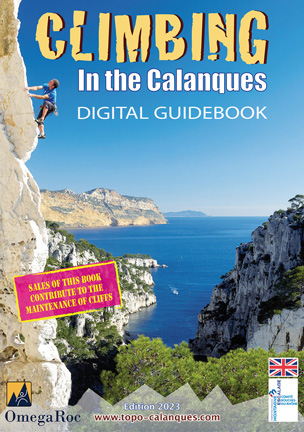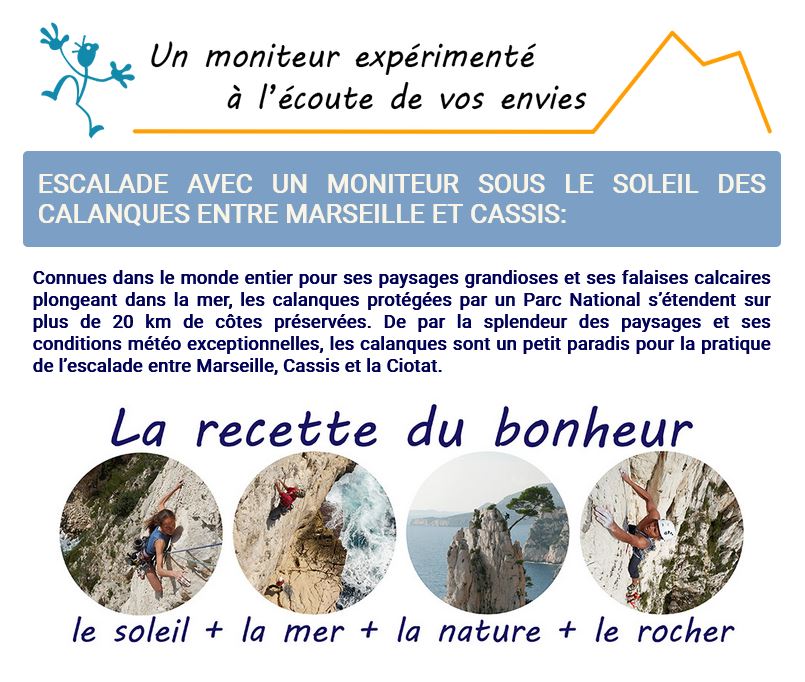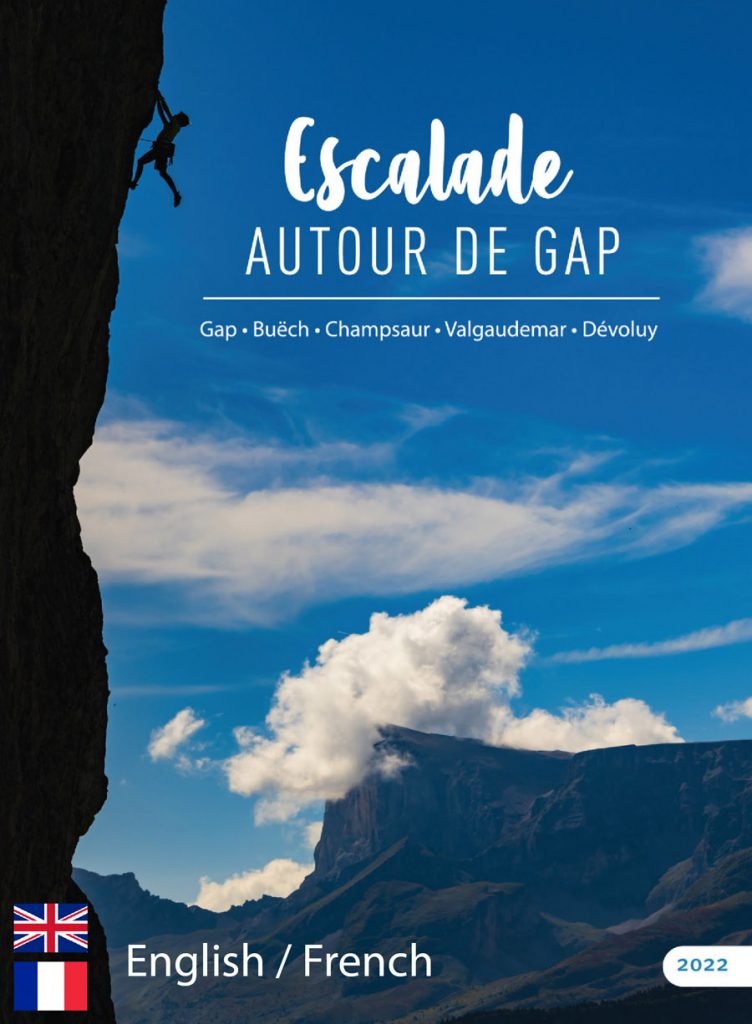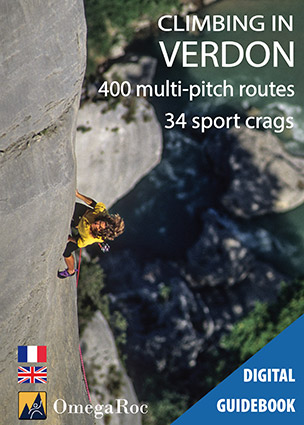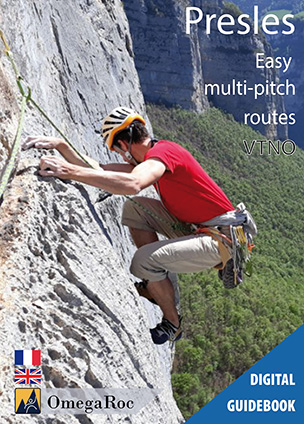
The digital guidebook Climbing in the Calanques – Edition 2023
See the guidebook in the OmegaRoc app
This guidebook is the digital version of the hard copy Climbing in the Calanques (2023 edition). It presents a large selection of climbing routes in the Calanques, both sports crags and sectors of multi-pitch routes. It was designed respecting several criteria: provide a description of the Calanques that is as thorough as possible, meet climbers’ expectations and preferences, and arouse interest in all types of climbing.
The routes are drawn on photos, the accesses are described precisely and are illustrated with maps. For each cliff, approach time is indicated as well as the length of rope required, aspect, number of routes, the average difficulty, and the range of grades.
This guidebook has been produced by Les Grimpeurs association and published by the CT FFME Bouches-du-Rhône (the local branch of the national climbing federation)
To know more about the guide: Click here
Some climbing history…
The history of climbing in the Calanques began in 1879 with the ascent of la Grande Candelle and follows the evolution of climbing in Europe. The motivation of the first climbers is turned towards the conquest of the summits. Summits that are reached by more and more difficult routes. Equipment evolutions are of course changing the performance, and thanks to the invention of pitons, the artificial climbing technique is developing. It was at this time that Gaston Rébuffat and Georges Livanos (known as Le Grec) two Marseille, internationally renowned climbers, frequented the Calanque massif. The climbing level caught up with the hardest routes in the Dolomites, the mecca of rock climbing.
Over the years, climbing found its course, increasingly independent of mountaineering. The pitons were followed by the first expansion bolts and then the battery-powered drills. As elsewhere in Europe, the level was exploding and number of sport crags multiplying.
Since 2012, a new player has appeared and has considerably influenced the rest of the story: The Calanques National Park (PNC) and the specific regulations resulting from it.
In the Calanques, the cliffs are directly influenced by sea winds and the steel material corrodes extremely quickly and often requires systematic rebolting. Over the past twenty years, route setters have also (and above all) become rebolters. These are the new heroes of the Calanques…
This is just a very quick overview of 150 years of climbing history in the Calanques.
To find out more: Click here.
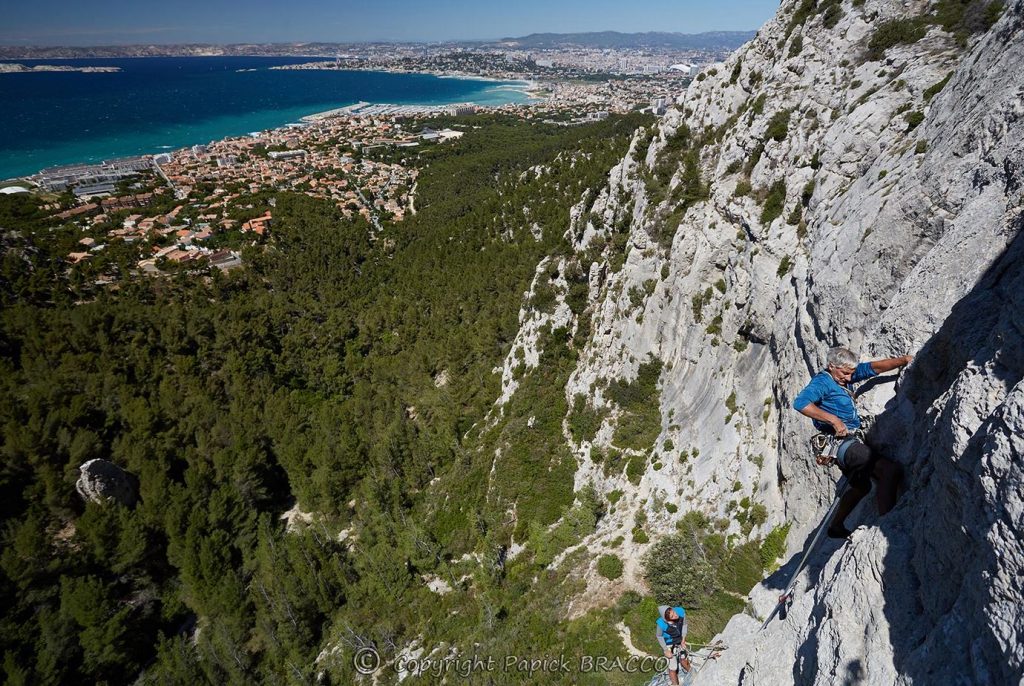
Climbing in the Calanques of Marseille
Beyond the activity itself, climbing in the Calanques is climbing in a unique universe, dominated by minerals and the nearby sea.
In a haven of nature, this pocket of freedom in the heart of a hyper-urbanized region, the Great Gardener knew how to grow the rocks like nowhere else. Hundreds of white limestone cliffs bristle in this gigantic Zen garden. The colours are sharp: the dazzling white of the rock rising from the deep blue sea, and the vegetation covers the valley bottoms with green and splatters the slopes and ledges. In the background there’s the sky, scorched by the summer sun, deeper when the winter mistral blows and decide the tone.
Climbing in such a universe is a privileged activity.
The climbing :
The white colour and compactness of the Calanques limestone is characteristic for the Urgonian type limestone. On generally very steep profiles, the climbing is rather technical on small holds as soon as the grade rises. But these are only generalities which do not reflect the extreme diversity of climbing in the Calanques which spans from slab covered with water drops to roofs at the top of the caves.
The Calanques is also famous for airy traverses directly overlooking the sea. These extraordinary journeys are reserved for homogeneous and resourceful rope parties since some traverses require a lot of rope work and a lot of flair.
Ridge routes is another specialty of the area. In the Calanques, the relief often takes the form of needles, blades or limestone mesas, creating ridges so tempting (and more accessible than the faces) that they were often the goal of the first climbers of the massif. The climbing here is generally at moderate grade and the setting is always breath-taking. Some, like the Arête de la Cordée (the Cordée ridge) and l’Arête de Marseille (the Marseille ridge), have become hyper-classics.
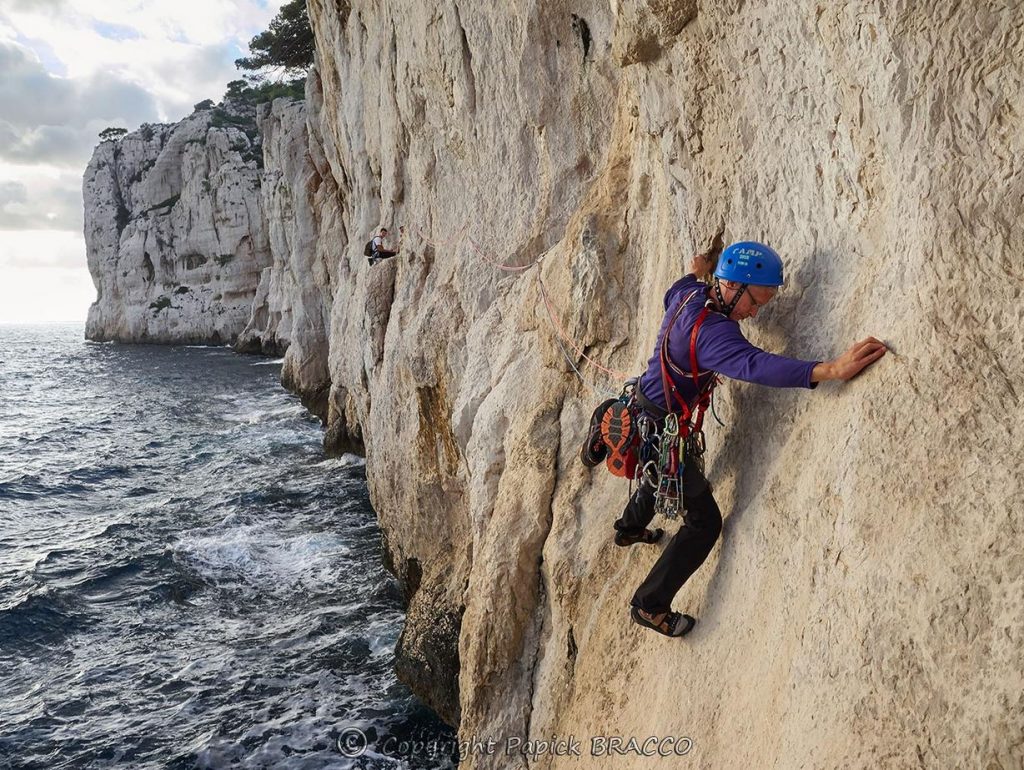
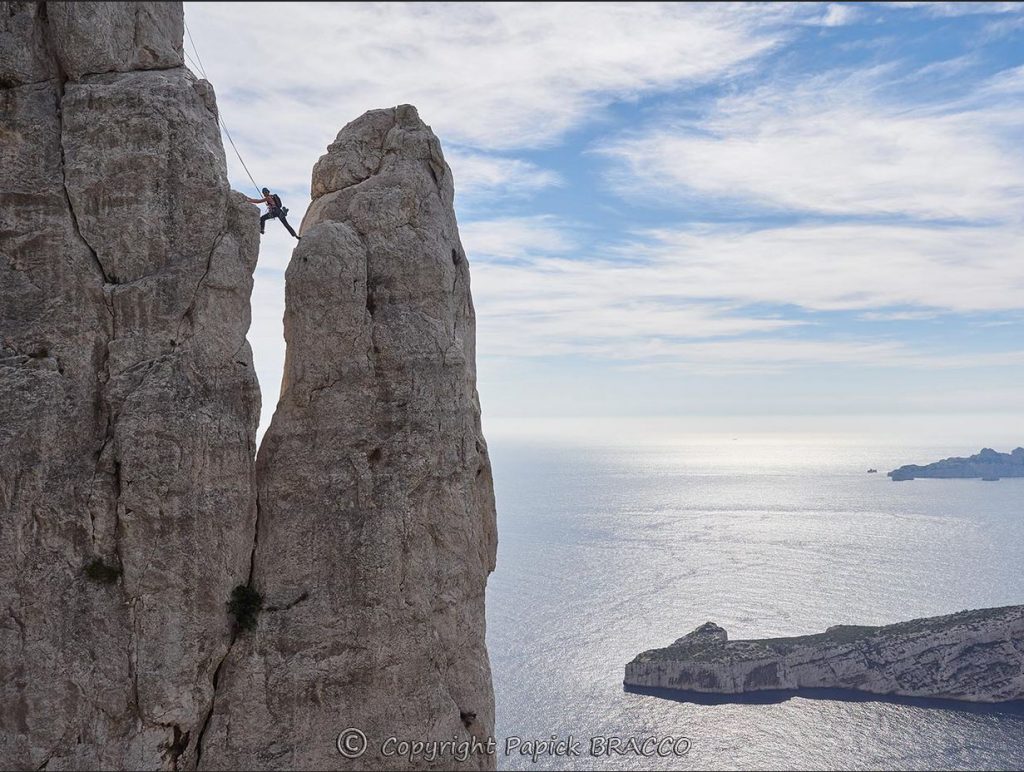
Climbing in the Calanques also means rubbing shoulders with more than a century of climbing history. On certain cliffs, modern sport crags coexist in harmony with historical multi-pitch routes, re-bolted or not, and artificial routes.
Unfortunately, more than a hundred years of climbing leaves traces, even on the best limestone like here. Several historic routes at moderate grade are heavily polished. But hey, once again there are so many and of top quality…
The only ones who would have the right to complain are the “ninthers”. Indeed the Calanques lack extreme routes with “only” four 9a listed in 2023. This is the only thing that you will not find here in large quantities. But there are several projects to release… Mutants welcome!
The bolting :
First thing: When facing dodgy fixed equipment, nothing can replace caution and common sense.
In the Calanques and on other crags in the area, corrosion is very important. The CT13 FFME committee has been checking the fixed equipment on the crags for more than thirty years. The tests enable the committee to better understand the deterioration of some materials, and evaluate the resistance of steel, stainless steel and the glue applied to sealed anchors. The tests performed by the committee show that the fixed equipment is generally reliable.
Many multi-pitch routes (not always many pitches by the way) have not been systematically re-bolted and you can find everything. The worst rubs shoulders with the best! To venture into these routes where the bolts in place are not always replaceable by friends or nuts, it is preferable to have some expertise in the “aging of materials in marine environments”.
Start your learning journey by reading the chapter dealing with equipment in the climbing guide.
You can find everything in the Calanques, but as you can find excellent things at all levels and in all styles, on crags or in multi-pitch and this for three lives as a climber, you would have to be a masochist to voluntarily cram yourself into trouble. Unless you are a fan of the big thrill… and that is respected.
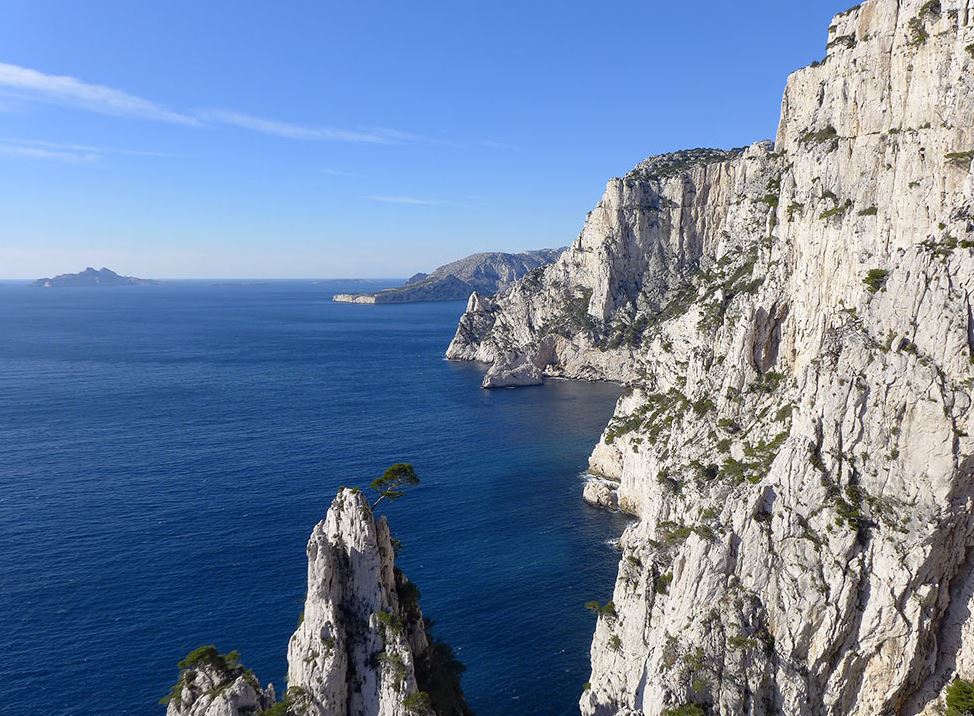
The Calanques National Park
The Calanques massif is a haven of nature with exceptional biodiversity in the heart of a densely populated region. In addition to human impact, voluntary or not, there is lack of water in the summer season also resulting in very high risk of fires.
To protect the massif, the Calanques National Park (PNC) was created in 2012. It covers both land and sea. Indispensable to preserve the massif, the PNC has been controversial since its creation because of regulations on outdoor activities that many consider inappropriate and inconsistent.
To know a lot more about the PNC:
– The following chapters of the introduction of the guidebook: Protecting the Calanques and PNC.
– The PNC website
– The specific pages of the Marseille Tourist Office website
To find out more about the regulations:
The Access regulation and Other regulations chapters of the guidebook
Dedicated pages of the PNC website PNC
More photos?
The photos in this web page have been kindly provided by Papick Bracco, photographer and climbing instructor based in Marseille. To see many more of his photos, go to the gallery on his internet site: Bonnegrimpe.com
It happens in the Calanques…
Superbe images of a very airy edge traverse. Unfortunately only in french.
NB: The drone flights are not allowed anymore.
A great video to get a good idea of what climbing the Calanques is.
Bilboquet (7b), a great classic at Grotte de l’Ours – Les Goudes
An other very famous crag: La Paroi des Toits.
Lisa Cossantelli sends La vrai vie (7b+)
Explore the crags in the neighborhood
Here are somme digital guidebooks for climbing in the surroundings areas.
To see all the guidebooks available on the OmegaRoc app: The OmegaRoc guidebooks

